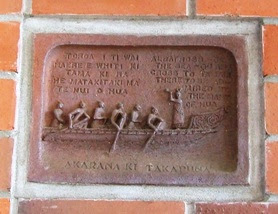I have been trying to get out to see the Howick Historical Village for absolutely ages. Finally last Sunday, thanks to Mt Albert Historical Society, I was able to tag along in their bus. Despite the ongoing 'flu feeling, coughing, and the grey ol' day -- I was determined to go. Glad I did.
Here, on their once a month live days (they're open every day, but the third Sunday of the month is special), Queen Vic's flag still flies.
We were warmly greeted by the residents, although considering the chap in the coat was the town cryer, we heard nothing more from him after this ...
I think this is supposed to be a facsimilie of Private James Hanson's tent.
It was where the 65th regiment based at the village were hanging out ...
... their colonial washing.
Then off they go to keep the village secure. Had to watch out, these guys could come on you suddenly if you are too occupied with taking photos (as I was).
Checking the equipment on parade.
Bayonets fixed ...
Starting the charge across the green, enemy sighted ...
Well, that's one hedge that won't try taking on the might of the British Empire again, eh wot?
All sorted, it's off again to see if there's some more shrubbery elsewhere just asking for a taste of Imperial steel.
I loved this wagon.
The village is wonderful, and certainly a place you could spend hours looking around. From raupo huts ...
... to sod cottages ...
... to charcoal burners ...
... early classrooms ...
... beautiful old schools ...
.... and Bycroft's flour mill. For a gold coin in the slot, the water's turned on and the wheel goes round. All very cool stuff for us history buffs.
To the right is a peck measure, and to the left one for the bushel. In the middle is a sieve.
Bycroft's millstones from Onehunga.
Howick Methodist Church.
A fire extinguisher. "This large fire extinguisher was made in 1920 for the Shell Oil Company when petrol was imported in cans. To operate, the brass handle was turned, puncturing a cylinder of oxblood, producing a yellow foam that extinguishes petrol fires. Used until 1985." (!!)
Had the offer of a sample of kumara roasted from the open fire (I said no, as I had eaten earlier).
Ginger beer, $2.50, said the signs inside the pub. When I asked how they were making their ginger beer, I was told that they couldn't make their own, thanks to OSH regulations, and offered me a Bundaberg instead. I declined. (Though, yes, I do like Bundaberg).
Behold -- Jean Batten's dunny.
Yes,
the Jean Batten. You know ... the aviatrix. Yes, that one.
You don't believe me? Tch! See for yourself.
See? Told you.
There's a sign inside asking folks to kindly not use it as a dunny. On seeing a lone fly buzzing around in there, I ventured no further.
Puhi Nui, built for William McLaughlin in 1861, according to the guidebook. The design was popular back then, taken from American house plan books.
I loved the detail at the bay window.
This wee bloke, forever guarding the wet umbrellas, looks a bit Boer War era to me.
The ladies are busy with their crafts ...
... while the dining room is already set for tea.
Finally, this is apparently a bit of Aussie -- a postbox from Sydney, 1869, where it was originally called a "street letter receiver."
I want to go back to the village, on a nice sunny live Sunday. I'll wait for my next opportunity -- it will be worth it.

















































































